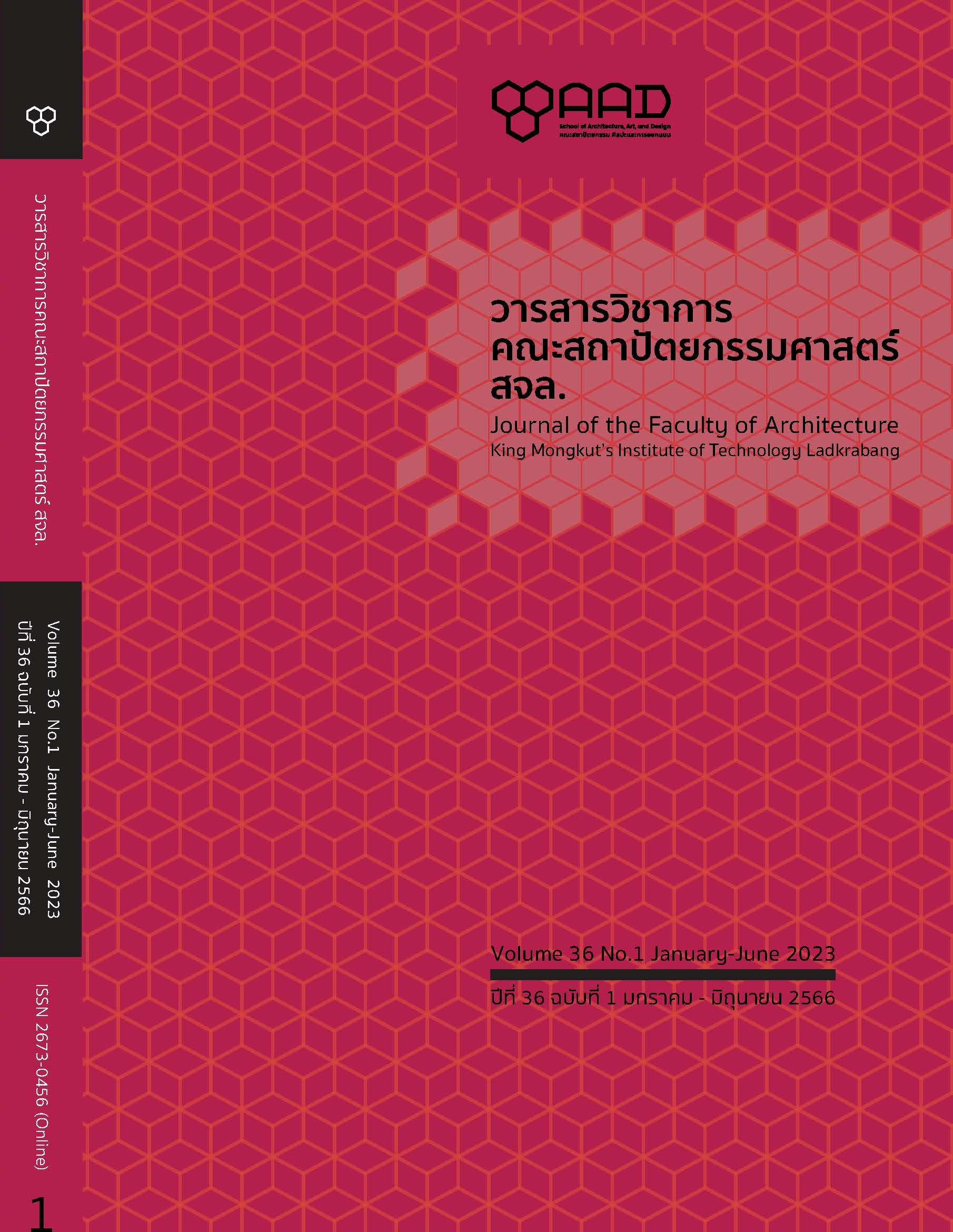Adaptive-Reuse of Timber Rowhouses in Hua Takhe Waterfront Community, Bangkok through Gentrification Phenomenon
Main Article Content
Abstract
This research aimed to explore role of gentrification affecting to change in architecture, society, and community lifestyles, through adaptive-reuse of existing timber rowhouses, including analyzing through attitudes of residents and entrepreneurs resulting from gentrification. To discuss on changes of new uses occurring in timber rowhouses, Hua Takhe community, data was collected by fieldwork, interviews, surveys, literature review, and relevant documents. From studying the phenomenon of gentrification, questions arise regarding how this phenomenon and people's attitudes contribute to use transformation of timber rowhouses in the community. In comparative study on buildings that have been repurposed by entrepreneurs, it was found that the gentrification has led to amendments of physical and architecture in through community's usage of space. These changes are intended to accommodate the new usage respond to the trend of nostalgia tourism. Consequently, new activities can emerge to the local that traditionally coexist. It was found that changes in architectural characteristics and usage of timber rowhouses are in line with the objectives of usage that respond to the growth of tourism. When analyzing with methods of changing physical characteristics of the building, it was found that entrepreneurs often repair and renovate buildings similar to the original style - facade and structure. With the idea of façade preservation, the overall environment is consistently maintained with the context while uses maybe varies demonstrating coexistence between entrepreneurs and the people in the community. In summary, attitudes of the entrepreneurs are importantly for the development and preservation of the community, both economically and socially. Through gentrification, good knowledge and understanding of the situation can lead to strong community in terms of harmonization between entrepreneurs and local way of living.
Article Details

This work is licensed under a Creative Commons Attribution-NonCommercial-NoDerivatives 4.0 International License.
This work is licensed under a Creative Commons Attribution-NonCommercial-ShareAlike 4.0 International License.
Copyright Transfer Statement
The copyright of this article is transferred to Journal of The Faculty of Architecture King Mongkut's Institute of Technology Ladkrabang with effect if and when the article is accepted for publication. The copyright transfer covers the exclusive right to reproduce and distribute the article, including reprints, translations, photographic reproductions, electronic form (offline, online) or any other reproductions of similar nature.
The author warrants that this contribution is original and that he/she has full power to make this grant. The author signs for and accepts responsibility for releasing this material on behalf of any and all co-authors.
References
จาตุรงค์ โพคะรัตน์ศิริ. (2546). การศึกษาปรากฏการณ์ “เจนตริฟิเคชั่น” ในการอนุรักษ์ชุมชนเมือง : กรณีผลกระทบทางสังคมในย่านชุมชนบางลำพู กรุงเทพมหานคร. (วิทยานิพนธ์ปริญญาการวางแผนภาคและเมืองมหาบัณฑิต สาขาวิชาการวางแผนชุมชนเมือง และสภาพแวดล้อม บัณฑิตวิทยาลัย สถาบันเทคโนโลยีพระจอมเกล้าเจ้าคุณทหารลาดกระบัง).
ชาตรี ประกิตนนทการ. (2554). สถาปัตยกรรมกับสังคมไทยยุคสมัยใหม่. กรุงเทพฯ: คณะสถาปัตยกรรมศาสตร์มหาวิทยาลัยศิลปากร.
ดนัย จันทร์เจ้าฉาย. (2553). White Ocean Strategy กลยุทธ์น่านน้ำสีขาว. กรุงเทพฯ: ดีเอ็มจี.
พัฒนา กิติอาษา (ผู้รวบรวม). (2546). มานุษยวิทยากับการศึกษาปรากฏการณ์โหยหาอดีตในสังคมไทยร่วมสมัย. กรุงเทพฯ: ศูนย์มานุษยวิทยาสิรินธร (องค์การมหาชน).
พีรยา บุญประสงค์. (2553). การปรับปรุงอาคารประวัติศาสตร์เพื่อการใช้สอยในบริบทใหม่อย่างสร้างสรรค์ กรณีศึกษา การปรับปรุงอาคารเควกเกอร์ไฟร์เออร์ส (Quaker Friar’s) เมืองบริสโทล ประเทศอังกฤษ. วารสารหน้าจั่ว ว่าด้วยประวัติศาสตร์สถาปัตยกรรม และสถาปัตยกรรมไทย. 7(กันยายน 2553 - สิงหาคม 2554), 279-307.
พีรยา บุญประสงค์. (2565). การออกแบบโครงการเพื่อการปรับเปลี่ยนการใช้สอยในอาคารเก่า. นครปฐม: สาละพิมพการ.
ภูรี อำพันสุข และวิมลรัตน์ อิสระธรรมนูญ. (2562). การปรับประโยชน์ใช้สอยอาคารประวัติศาสตร์เพื่อเป็นพื้นที่การเรียนรู้สร้างสรรค์ กรณีศึกษา อาคารในพื้นที่อนุรักษ์ของกรุงเทพมหานคร. วารสารสาระศาสตร์. 3(2562), 367-379.
ยงธนิศร์ พิมลเสถียร. (2557). การปรับปรุงฟื้นฟูเมืองและการอนุรักษ์เมือง. กรุงเทพฯ: สำนักพิมพ์มหาวิทยาลัยธรรมศาสตร์
ศักดิ์โชค มโนภครัตน์. (2537). แนวทางการพัฒนาชุมชนหัวตะเข้ เมืองศูนย์กลางของเขตลาดกระบัง กรุงเทพมหานคร. (วิทยานิพนธ์ สาขาวิชาการวางแผนชุมชนเมืองและสภาพแวดล้อม บัณฑิตวิทยาลัย สถาบันเทคโนโลยีพระจอมเกล้าเจ้าคุณทหารลาดกระบัง).
สิรัชญา วงษ์อาทิตย์. (2558). ปัจจัยที่มีผลต่อการท่องเที่ยวเชิงโหยหาอดีตของนักท่องเที่ยวชาวไทย (วิทยานิพนธ์ปริญญาบริหารธุรกิจมหาบัณฑิต มหาวิทยาลัยเกษตรศาสตร์).
Atkinson, R., & Bridge, G. (2005). Gentrification in a Global Context: The New Urban Colonialism. London: Routledge.
Geddes P. (1947). Town Planning in Kapurthala. A Report to H.H. the Maharaja of Kapurthala, 1917. London: Lund Humphries.
Glass R. (1964). Introduction: Aspects of Change. In Center for urban studies (ed.). London : Aspects of Change. (pp. xiii-xlii). London: MacKibbon and Kee.
Lees L., Slater T. and Wyly E. (2008). Gentrification. New York: Routledge.
MacDonald, J., Branas, C., and Stokes, C. (2019). Changing Places: The Science and Art of New Urban Planning. New Jersey: Princeton University Press.
Palen and London (1984). Gentrification, Displacement, and Neighborhood Revitalization. Albany: State University of New York Press.
Smith, N. (1996). The new urban frontier: Gentrification and the revanchist city. London: Routledge.


